
William Logsdail stands as a significant, if sometimes overlooked, figure in the landscape of late Victorian and Edwardian British art. Born in the historic city of Lincoln in 1859 and living until 1944, his career spanned a period of immense social and artistic change. Logsdail distinguished himself primarily as a painter of landscapes, particularly urban scenes, as well as portraits and occasional still lifes. His work is characterized by a compelling blend of meticulous realism, influenced by his training and the prevailing academic tastes, combined with a sensitivity to light and atmosphere that aligns him with aspects of Naturalism and Impressionism. He is perhaps best remembered for his evocative and detailed depictions of London and Venice, capturing the unique character and energy of these great cities with remarkable fidelity and artistic flair.
Early Life and Artistic Awakening in Lincoln
William Logsdail was born on May 25, 1859, in Lincoln, Lincolnshire, a city dominated by its magnificent medieval cathedral. This environment likely played a role in fostering his appreciation for architecture, a subject that would feature prominently in his later work. His father held the position of verger at Lincoln Cathedral, providing young William with intimate access to the grandeur and intricate details of the structure. His artistic inclinations emerged early; records show that at the tender age of 12, he demonstrated notable skill, winning a second prize in a local competition for a work based on "shading from the cast model."
His formal art education began locally at the Lincoln School of Art and Design. Here, he came under the guidance of Edward R. Taylor, the school's headmaster, who recognized the young man's potential and encouraged him. Taylor's influence was significant, particularly in steering Logsdail towards developing his skills in architectural drawing and representation, a foundation that would prove invaluable throughout his career. By the age of 16, Logsdail was already exhibiting his work locally, showcasing a precocious talent that pointed towards a promising future in the arts. This early success and training in Lincoln laid the groundwork for his subsequent move to the larger artistic centers of England and Europe.
Forging an Artist in London and Antwerp
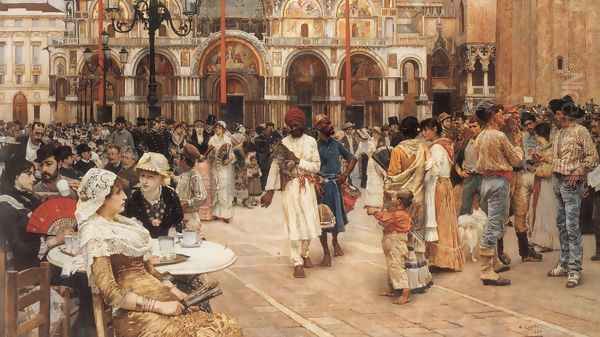
Seeking broader horizons and more advanced training, Logsdail moved to London in 1876. He enrolled at the National Art Training School in South Kensington (the precursor to the Royal College of Art). This period exposed him to the vibrant London art scene and the ongoing debates surrounding art education and design reform, although his primary focus remained on developing his painting technique. His talent continued to mature, leading to his acceptance into the prestigious Royal Academy Schools in 1881. This marked a significant step, placing him within the heart of the British art establishment.
Before fully immersing himself in the London scene, however, Logsdail sought further experience abroad. He traveled to Antwerp, Belgium, a city with a rich artistic heritage, particularly associated with masters like Peter Paul Rubens. In Antwerp, he studied at the Académie Royale des Beaux-Arts. Crucially, during this time, he formed a close association with fellow British artist Frank Bramley. Bramley would become a prominent member of the Newlyn School of painters in Cornwall, known for their naturalist depictions of rural life. Logsdail and Bramley's shared time in Antwerp, honing their skills in a continental academic setting, forged a lasting connection and provided Logsdail with valuable exposure to different artistic approaches and influences beyond those prevalent in Britain.
The Venetian Experience: Light, Architecture, and Encounters
In 1881, Logsdail embarked on a journey that would profoundly shape his artistic vision: he traveled to Venice. The city, with its unique interplay of water, light, and magnificent architecture, captivated him. This period proved immensely productive and influential. Working extensively en plein air (outdoors), Logsdail developed his ability to capture the fleeting effects of light and atmosphere, pushing his style towards a brighter palette and a more naturalistic rendering of scenes, while retaining his characteristic attention to detail. Venice offered a wealth of subjects, from grand vistas of canals and palaces to intimate glimpses of daily life in its campi and calli.
During his time in Venice, Logsdail's circle expanded. He reconnected with Frank Bramley and met Mary Ashman, another artist who would later become his wife. Venice was also a magnet for international artists, and Logsdail encountered several prominent figures. Among them were American painters like Frank Duveneck and Robert Blum, whose bravura brushwork and realist tendencies offered stimulating points of comparison. He also likely crossed paths with the renowned expatriate artists James McNeill Whistler and John Singer Sargent, both of whom spent time painting in Venice and were masters of capturing its unique ambiance, albeit with different stylistic emphases. Another notable contemporary Logsdail encountered in Venice was John William Waterhouse, a painter known for his mythological and Pre-Raphaelite-influenced works.
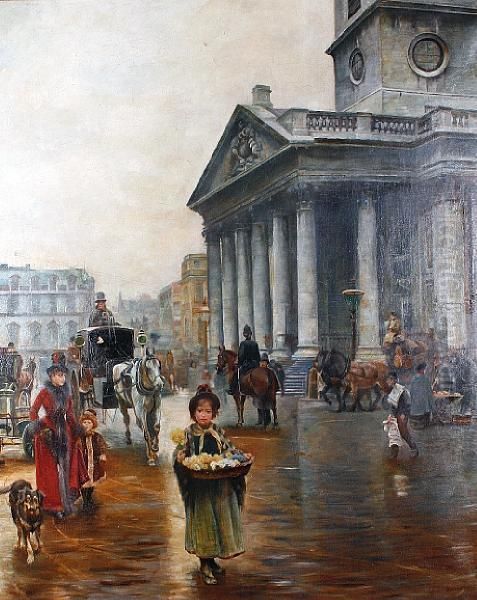
The Venetian period yielded some of Logsdail's most celebrated works. His painting Piazza of St Marks, Venice, completed in 1883, is a masterful depiction of the famous square, teeming with life and rendered with astonishing architectural accuracy and vibrant light. It showcases his ability to handle complex compositions involving numerous figures and intricate architectural settings. His Venetian scenes were exhibited back in Britain and received considerable acclaim, helping to establish his reputation as a painter of exceptional technical skill and keen observation. The success of these works demonstrated his unique ability to combine topographical accuracy with a lively, almost photographic, sense of immediacy.
Capturing the Metropolis: London Scenes and Recognition
Following his productive periods abroad, Logsdail turned his attention increasingly to his native country's capital: London. He applied the observational skills and techniques honed in Venice to the bustling streets and iconic landmarks of the British metropolis. His London paintings are remarkable for their detailed realism and their ability to convey the specific atmosphere of the city – often depicted under the grey, diffused light characteristic of the British climate, or capturing the dampness of rain-slicked pavements and the hazy effects of fog.
One of his most famous London works is St Martin-in-the-Fields, painted in 1888. This large canvas depicts Trafalgar Square, looking towards the church, on a damp day. Logsdail masterfully captures the textures of wet stone, the varied fabrics of clothing, and the complex interplay of reflections on the ground. The painting is a tour-de-force of urban realism, populated with numerous figures representing a cross-section of London society, from flower sellers to businessmen. It demonstrates his skill in composing large, complex scenes and his eye for social detail, creating a vivid snapshot of late Victorian London life.
Another significant London painting is The Bank of England, which portrays the imposing neoclassical facade of the institution at the heart of the City of London. This work again highlights Logsdail's strength in architectural rendering, capturing the building's solidity and grandeur, while the surrounding street life adds dynamism to the scene. These major works, along with others, were exhibited prominently at the Royal Academy, as well as other important venues like the Grosvenor Gallery and the New Gallery. His success was further cemented when one of his paintings, The Fish Market, was purchased by Queen Victoria herself, a significant mark of royal patronage and public recognition. Logsdail became known for his ability to tackle large-scale, complex urban subjects that few contemporaries attempted with such fidelity.
A Shift Towards Portraiture and Later Life
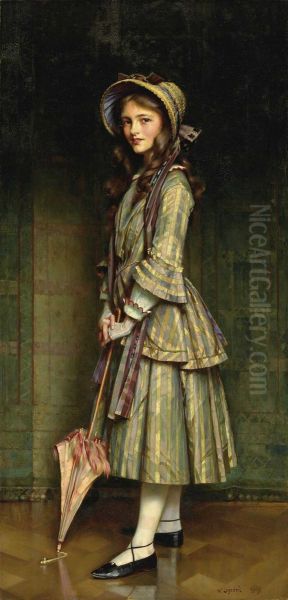
Around the turn of the century, Logsdail's artistic focus began to shift. While he continued to paint landscapes and cityscapes occasionally, portraiture became an increasingly important part of his output. This change may have been influenced by several factors, including the changing art market, the potential for lucrative commissions, and perhaps health considerations. Logsdail had suffered health problems, reportedly due to the rigors of prolonged outdoor painting sessions in varying weather conditions. Around 1890, he spent time convalescing in the South of France, seeking a warmer climate to aid his recovery.
In 1892, Logsdail married the artist Mary Ashman, whom he had met years earlier in Venice. The couple lived in Venice for a period, from 1892 until 1900, before returning to settle in England. Back in London, Logsdail established himself as a capable portrait painter. His portraits often depicted family members, friends, and commissioned subjects, sometimes reflecting an interest in capturing specific "types" or characters representative of the British Empire during the Edwardian era.
One notable work from this period is An Early Victorian (also known as Portrait of the Artist's Daughter, Mary). Exhibited at the Royal Academy, this charming portrait received positive notice and demonstrated his skill in capturing likeness and character with sensitivity. However, in his later years, Logsdail's artistic production gradually declined. He developed a condition affecting his hands, which made the detailed work required by his style increasingly difficult. Despite these challenges, he continued to be associated with the art world. William Logsdail passed away on September 3, 1944, at the age of 85, leaving behind a substantial body of work that documented his times with remarkable clarity.
Logsdail's Artistic Style: A Synthesis of Observation and Technique
William Logsdail's artistic style is best understood as a synthesis of several contemporary trends, adapted to his own meticulous temperament and interests. At its core, his work is grounded in Realism, demonstrating a commitment to accurate observation and detailed rendering, particularly evident in his treatment of architecture and complex urban environments. This aligns him with the broader Victorian taste for verisimilitude and narrative clarity in painting. His training, especially the emphasis on draughtsmanship at institutions like the Lincoln School of Art and the Royal Academy Schools, provided the technical foundation for this detailed approach.
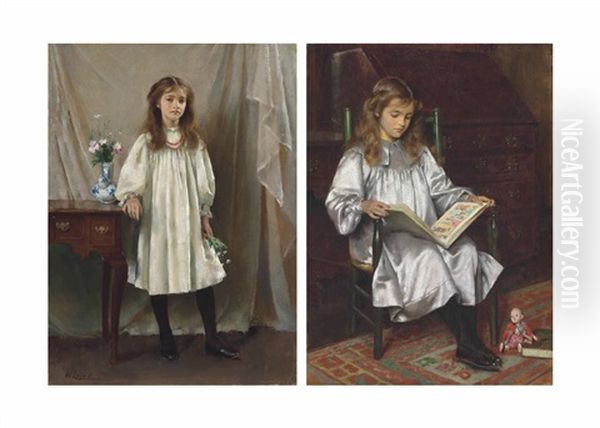
However, Logsdail was not merely a topographical painter. His time spent working outdoors, especially in Venice, infused his work with elements of Naturalism and Impressionism. Like the French Impressionists, such as Claude Monet or Camille Pissarro, Logsdail was deeply interested in the effects of light and atmosphere. He skillfully captured the specific quality of light in different locations and times of day – the bright Mediterranean sun in Venice, the softer, often overcast light of London, the reflections on wet surfaces. While his brushwork generally remained tighter and more controlled than that of the core French Impressionists, his sensitivity to transient effects and his practice of en plein air painting connect him to their concerns.
His approach differed significantly from other major currents in British art of the time. He did not embrace the symbolism or aestheticism of artists like James McNeill Whistler (despite meeting him), nor did he follow the path of the earlier Pre-Raphaelite Brotherhood (e.g., Dante Gabriel Rossetti, John Everett Millais) with their emphasis on literary subjects and jewel-like detail. Logsdail's focus remained firmly on the observable world, whether it was the structure of a building, the bustle of a crowd, or the play of light on stone. His technique involved careful layering and precise drawing, combined with an ability to render textures convincingly – from the rough stone of ancient buildings to the smooth silk of contemporary dress. This blend of academic precision and heightened naturalistic observation defines his unique contribution.
Analysis of Major Works
A closer look at some of Logsdail's key paintings reveals the consistent strengths and evolution of his art.
Piazza of St Marks, Venice (1883): This painting remains one of his most iconic achievements. It presents a panoramic view of the famous square, filled with Venetians and tourists. The architectural details of St Mark's Basilica, the Campanile, and the surrounding buildings are rendered with extraordinary precision, demonstrating his mastery of perspective and architectural drawing. Yet, the work is far from static; the figures are lively and individualized, and the bright Venetian sunlight illuminates the scene, creating strong contrasts and vibrant colours. It stands as a modern successor to the Venetian view paintings of Canaletto or Francesco Guardi, but with a distinctly 19th-century realist sensibility and photographic clarity.
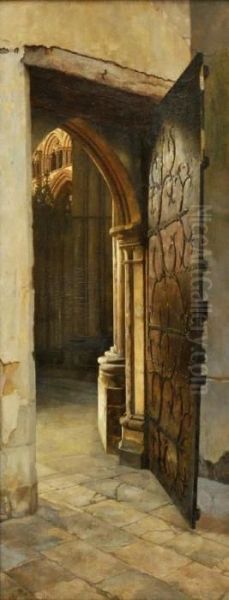
St Martin-in-the-Fields (1888): This ambitious London scene showcases Logsdail's ability to orchestrate a complex urban panorama. The composition leads the eye towards the church, framed by the surrounding buildings of Trafalgar Square. The depiction of the weather – a damp, overcast day – is masterfully handled, with subtle reflections on the wet ground and a muted colour palette appropriate to the London atmosphere. The painting functions almost as a social document, capturing the diverse mix of people navigating the city. Its detailed realism can be compared to the work of other Victorian urban painters, though Logsdail's focus on daylight and architectural accuracy distinguishes him from artists like Atkinson Grimshaw, known for his moonlit or gaslit scenes.
The Bank of England: Representing the heart of London's financial district, this painting emphasizes the power and stability embodied by the institution's architecture. Logsdail meticulously renders the classical details of the building, contrasting its imposing permanence with the ephemeral movement of carriages and pedestrians on the street below. The work conveys a sense of civic pride and order, characteristic of the Victorian era's confidence in its institutions. It is a prime example of Logsdail's skill in using architecture not just as a backdrop, but as a significant subject in itself.
An Early Victorian: This later portrait of his daughter Mary demonstrates Logsdail's capabilities in a different genre. While still detailed and realistic, the focus shifts to capturing character and personality. The painting evokes a sense of nostalgia through its title and the sitter's attire, reflecting an interest in historical periods even within a contemporary portrait. Its favourable reception at the Royal Academy confirmed his versatility as an artist who could move beyond landscape and cityscape.
His paintings of Lincoln Cathedral, executed at various points in his career, represent a return to his roots. These works show a deep, personal connection to the subject, rendered with the same architectural fidelity and sensitivity to light that characterize his more famous urban scenes. They underscore the enduring importance of his early environment and training.
Logsdail and His Contemporaries: Context and Connections
William Logsdail operated within a rich and diverse British art world. His career intersected with various movements and prominent figures. His early association with Frank Bramley connects him to the orbit of the Newlyn School. Although Logsdail did not adopt the rural subject matter typical of Newlyn painters like Stanhope Forbes or Walter Langley, he shared their commitment to Naturalism and often worked outdoors. His realistic urban scenes can be seen as a counterpart to the rural naturalism practiced by artists like George Clausen.
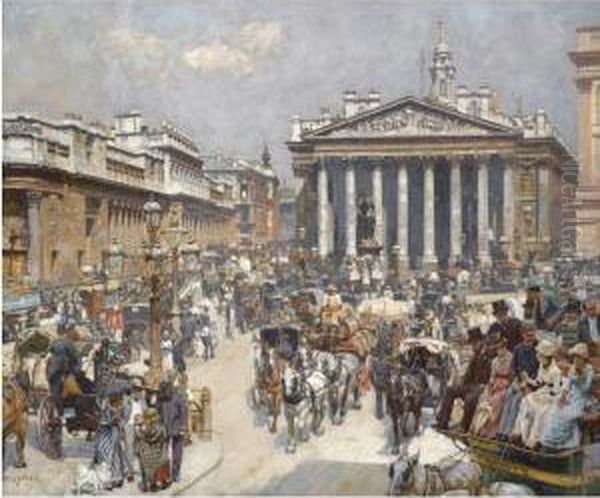
His time in Venice brought him into contact with major international figures like Whistler and Sargent. While Logsdail's style remained distinct, exposure to these artists, known for their sophisticated handling of paint and modern sensibilities, likely broadened his perspective. His detailed realism, however, set him apart from Whistler's tonal harmonies or Sargent's fluid brushwork. He also encountered John William Waterhouse in Venice, representing a link to the more romantic and mythological trends in British art.
Within the context of the Royal Academy, Logsdail's work offered a contrast to the dominant styles of High Victorian classicism, represented by figures like Frederic Leighton or Lawrence Alma-Tadema, whose works often featured historical or mythological subjects rendered with polished academic finish. Logsdail's focus on contemporary urban life and his blend of detailed realism with atmospheric effects positioned him closer to continental realism and certain aspects of Impressionism. His work also differed from the socially conscious realism of artists like Luke Fildes, as Logsdail's paintings, while documentary in detail, generally lacked overt social commentary. He carved out a niche for himself as a master of the complex urban scene, rendered with unparalleled detail and atmospheric truth.
Later Years, Legacy, and Historical Assessment
In his later decades, William Logsdail's output lessened, partly due to the physical ailment affecting his hands. He continued to live in England, passing away in Noke, Oxfordshire, in 1944. While highly regarded during his peak years, particularly for his large exhibition pieces at the Royal Academy, his reputation perhaps faded somewhat in the 20th century with the rise of modernism. However, recent decades have seen a renewed appreciation for Victorian and Edwardian art, leading to a reassessment of Logsdail's contribution.
His legacy rests primarily on his exceptional ability to capture the essence of late 19th and early 20th-century urban environments, especially London and Venice. His paintings serve as invaluable historical documents, recording the architecture, fashion, and daily life of the era with remarkable precision. Beyond their documentary value, they are significant artistic achievements, demonstrating a unique fusion of academic draughtsmanship, realist observation, and a sensitivity to light and atmosphere influenced by Impressionism. He tackled subjects of great complexity – crowded squares, intricate facades, specific weather conditions – with a confidence and skill that few contemporaries matched in the same genre.
Art historians now recognize Logsdail as an important figure in the transition period of British art, bridging the gap between traditional Victorian realism and the newer influences arriving from the continent. His dedication to capturing the visual truth of the world around him, combined with his technical mastery, ensures his place as a distinctive and accomplished painter. His works continue to engage viewers with their detailed accuracy, evocative atmospheres, and vivid portrayal of city life during a transformative period in history.
Conclusion
William Logsdail was a painter of remarkable skill and dedication, whose career produced a significant body of work characterized by meticulous realism, architectural accuracy, and a keen sensitivity to the nuances of light and atmosphere. From his early training in Lincoln to his formative experiences in Antwerp and Venice, and his celebrated depictions of London's bustling streets, Logsdail consistently pursued a vision grounded in careful observation of the world around him. While perhaps less famous than some of his contemporaries, his paintings, particularly his complex urban landscapes, stand as testaments to his technical prowess and his unique ability to chronicle the visual character of his time. As both an artist and a visual historian, William Logsdail made a lasting contribution to British art.